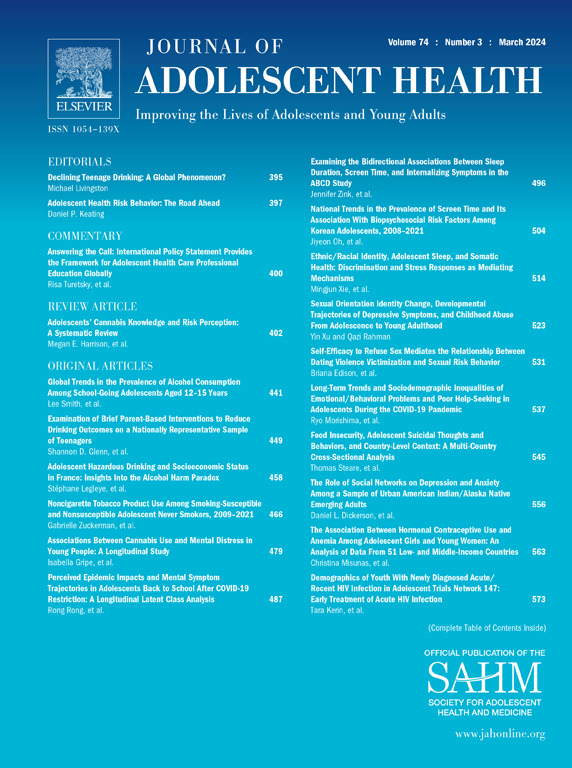Associations Between Social Media Use and Anxiety Among Adolescents: A Systematic Review Study
IF 4.5
2区 医学
Q1 PEDIATRICS
引用次数: 0
Abstract
Purpose
Studies show mixed associations between adolescent social media use and anxiety. This systematic review evaluated research on social media and anxiety among adolescents for direction of associations, social media measures, demographic stratification, anxiety measures, and study quality.
Methods
We searched for articles published in English before 2021 that tested associations between adolescent social media use and anxiety. Each study underwent screening and data extraction by two reviewers. Measures included direction of associations (positive, negative, null, mixed), social media measures, demographic group stratification, anxiety measures, and study quality (Strengthening of Reporting of Observational Studies in Epidemiology).
Results
A total of 32 studies were included. Over half reported positive associations between social media use and anxiety (56.3%). Problematic use was the most common social media measure type (31.4%). Positive associations with anxiety were predominantly observed for measures of problematic use (75.0%) and screen time (72.7%). Among other social media measures, 40.9% showed positive associations. A total of 18 anxiety measures were used. Four studies (12.5%) stratified findings by gender identity. The mean Strengthening of Reporting of Observational Studies in Epidemiology score was 34.1 (standard deviation = 4.3) out of 46.
Discussion
Future work should explore accurate social media use measures that are not based on problematic use.
青少年使用社交媒体与焦虑之间的关系:系统回顾研究。
目的:研究表明,青少年使用社交媒体与焦虑之间存在不同的关联。本系统性综述从关联方向、社交媒体测量、人口分层、焦虑测量和研究质量等方面对有关青少年社交媒体和焦虑的研究进行了评估:我们搜索了 2021 年之前发表的测试青少年使用社交媒体与焦虑之间关系的英文文章。每项研究均由两名审稿人进行筛选和数据提取。衡量标准包括相关性的方向(正向、负向、无效、混合)、社交媒体衡量标准、人口学群体分层、焦虑衡量标准和研究质量(加强流行病学观察性研究的报告):结果:共纳入 32 项研究。一半以上的研究报告了社交媒体使用与焦虑之间的正相关关系(56.3%)。有问题的使用是最常见的社交媒体测量类型(31.4%)。与焦虑呈正相关的主要是有问题的使用(75.0%)和屏幕时间(72.7%)。在其他社交媒体测量指标中,有 40.9% 显示出正相关。共使用了 18 种焦虑测量方法。四项研究(12.5%)按性别身份对研究结果进行了分层。流行病学中加强观察性研究报告的平均得分为 34.1(标准差 = 4.3),满分为 46.讨论:未来的工作应探索不以有问题的使用为基础的准确的社交媒体使用测量方法。
本文章由计算机程序翻译,如有差异,请以英文原文为准。
求助全文
约1分钟内获得全文
求助全文
来源期刊

Journal of Adolescent Health
医学-公共卫生、环境卫生与职业卫生
CiteScore
10.40
自引率
3.90%
发文量
526
审稿时长
46 days
期刊介绍:
The Journal of Adolescent Health is a scientific publication dedicated to enhancing the health and well-being of adolescents and young adults. Our Journal covers a broad range of research topics, spanning from the basic biological and behavioral sciences to public health and policy. We welcome a variety of contributions, including original research papers, concise reports, literature reviews, clinical case reports, opinion pieces, and letters to the editor. We encourage professionals from diverse disciplines such as Anthropology, Education, Ethics, Global Health, Health Services Research, Law, Medicine, Mental and Behavioral Health, Nursing, Nutrition, Psychology, Public Health and Policy, Social Work, Sociology, and Youth Development to share their expertise and contribute to our mission of promoting adolescent health. Moreover, we value the voices of young individuals, family and community members, and healthcare professionals, and encourage them to submit poetry, personal narratives, images, and other creative works that provide unique insights into the experiences of adolescents and young adults. By combining scientific peer-reviewed research with creative expressions, our Journal aims to create a comprehensive understanding of the challenges and opportunities in adolescent and young adult health.
 求助内容:
求助内容: 应助结果提醒方式:
应助结果提醒方式:


